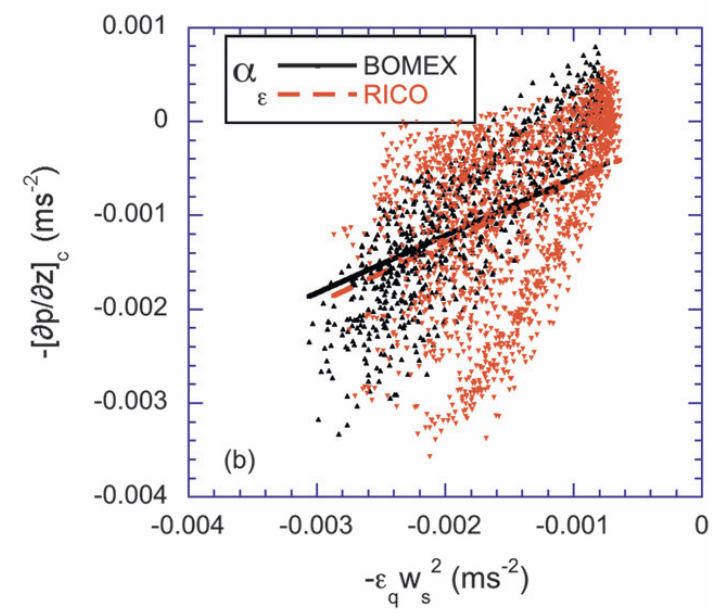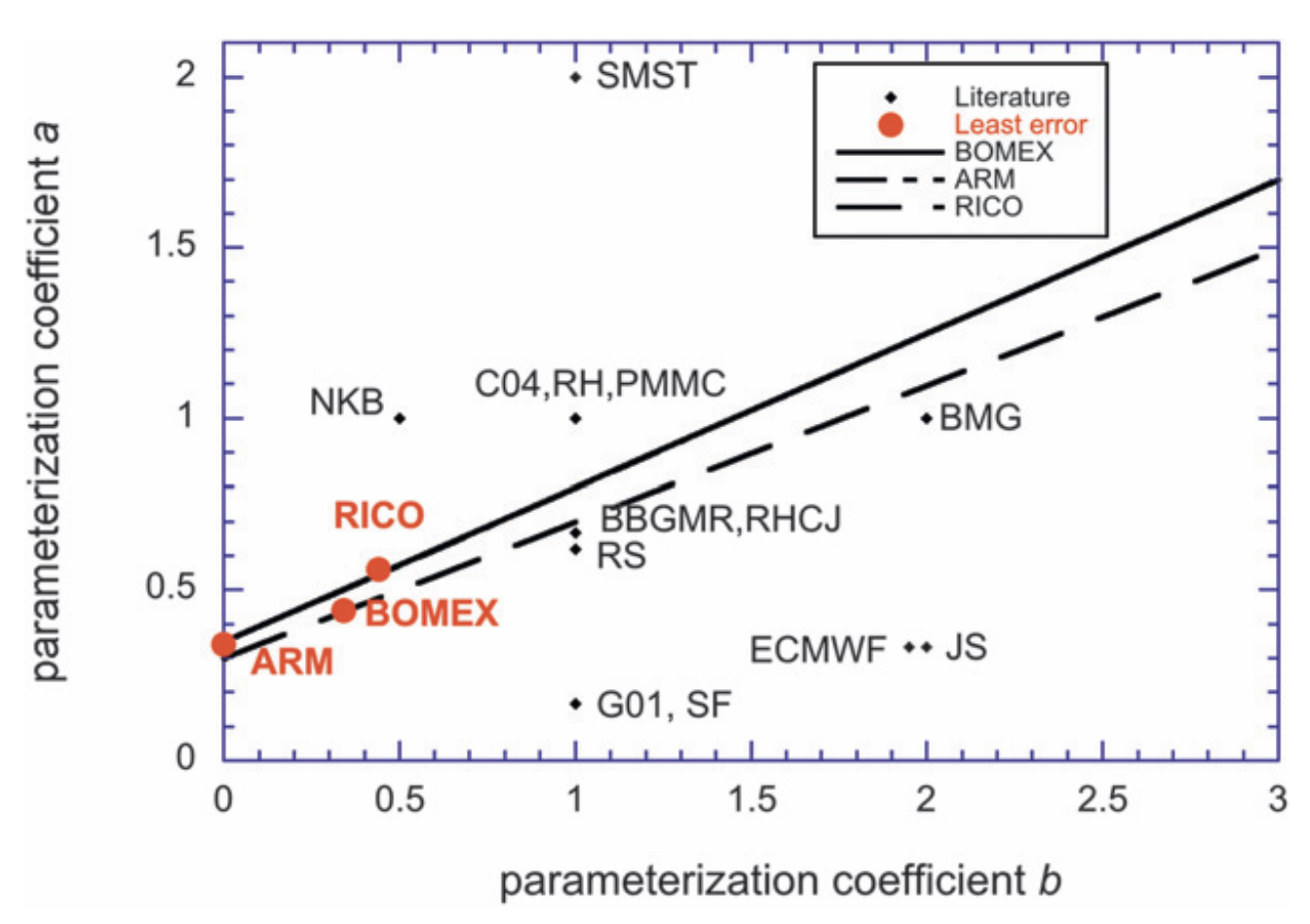I’ve been stewing on an idea to build a convective parameterization for a couple years, but there are a lot of issues to work out so I’ve been trying to study up on how other parameterizations work. The biggest issue with a convective parameterization always seems to revolve around entrainment. In reading about recent parameterization developments, like Chikira and Sugiyama (2010), many people seem to like the idea of relating entrainment to the vertical velocity of the cloud updraft. This is not a new idea, but it has taken awhile to be utilized in weather and climate models. The paper discussed below provides a great discussion of this relationship, and I was surprised to learn that it is based on an inaccurate assumption about how important entrainment is for cloud momentum.
To jump right into the important stuff, here’s the approximate form of the vertical velocity equation that is utilized by several cloud parameterizations:

where wc is the cloud updraft velocity, Bc is the cloud buoyancy, and ε is the entrainment. The coefficients a and b encompass the uncertainty in the relative influence of these processes. It’s easy to see how this might be an attractive way to diagnose the entrainment rate from cloud buoyancy and updraft velocity, since they are easy to define and measure. To really understand the issues with this relationship, we have to understand where it comes from.
The equation below provides a budget of a cloud’s vertical velocity tendency.

Here’s a run down of each term:
- Tend – This is the net tendency of a cloud’s vertical velocity from all the acceleration and drag forces.
- Buo – Acceleration due to buoyancy. This is the main force that makes the cloud rise upwards.
- Adv – Advection of buoyancy. Advection naturally acts to smooth out gradients, so we expect this term to have a small negative effect on cloud vertical velocity.
- Ent – Effect of entraining air from outside the cloud. This is often assumed to be similar to a drag force, but this isn’t always the case.
- Subplume – This represents mixing of momentum within the cloud.
- Pres – Pressure gradient force. This is the main drag force acting on the cloud as it rises.
- Cor – Coriolis torque. For a rising cloud at the equator, the coriolis torque can act to turn an updraft slightly to the West, but the effect is generally small so we can neglect it for our purposes here.
Note that there was a detrainment term, but it was eliminated by combining the momentum budget with an equation describing mass conservation. When running a model that can resolve cloud motions, the only quantity above that we can’t know directly is the entrainment. For this reason the authors calculate Ent as a residual.
The figure below shows the time averaged profile of each term above (except for Cor). The data was only calculated for the updraft regions, which can include air that is non-buoyant. The left panel suggests that the dominant balance is between the buoyancy acceleration and the drag caused by the pressure gradient.

In their discussion of the figure above the authors make this statement:
“The advection term is relatively small compared to the buoyancy forcing. This suggests that only a small fraction of the [CAPE] is converted into turbulent kinetic energy.“
I’m still very confused about this. I tried thinking about what it would mean for the advection term to be strongly negative, but I can’t see the connection they are making here. The next statement also caught my eye:
“Simpson and Wiggert (1969) suggest that the subplume term acts to reduce the buoyancy. The LES results indicate that it is in general a small term except for the levels just above the cloud base…”
I was curious about Simpson and Wiggert’s reasoning here, but skimming through their paper I wasn’t able to find any discussion of the sub-plume term.
The entrainment term is one of the more interesting aspects of the figure above. The fact that the effect of entrainment is positive implies that the actual mass entrainment rate is negative. I suspect that this could be due the effect of detrainment, even though it was algebraically eliminated. The authors give a different explanation that I honestly don’t quite understand, which has to do with decomposing the terms to account how changes in cloud mass or volume affect the momentum budget. The whole argument sounds a lot like an overly complicated description of detrainment to me.
“In addition to the horizontal flux of resolved and subgrid vertical momentum across the cloud boundaries, the lateral mixing term also includes terms that arise from the Leibniz rule. For example, some air parcels that are vertically accelerated may disappear from the cloud ensemble at the next time step, which is counted as lateral mixing of momentum.”
Getting back to the main point of the paper, it should be obvious from the figure above that the first equation is not a good approximation of the second, because the entrainment term is not a major player and it certainly is not acting to balance the buoyancy acceleration. The authors suggest that with certain combinations of parameters a and b the effects of pressure gradient drag can be implicitly taken into account, but it is not possible to have either buoyancy or entrainment to fully take on the duty of the pressure gradient term because there is insufficient correlations (see below).


The second figure above that compares the pressure gradient to the buoyancy indicates an interesting relationship that seems like it should be parameterizable.
The authors go on to show that if we take the first approximate equation that we started with at face value then there are numerous equally optimal estimates of the parameters a and b. Their final plot below reviews some of the choices previous studies have made in setting these parameters and compares them to the optimal choices found though analysis of observations. It seems clear that some of these previous choices were not valid (ex. SMST).

Overall, I’m left with a sense that we should not settle for this equation:
![]()
This paper convinced me that this is an invalid way to think about the budget of cloud updraft momentum. I don’t have an alternative, but I think it’s worth pursuing ways of parameterizing the pressure gradient term. This likely will involve assumptions about the “shape” of the convecting element, but I suspect this is a superior approach.
